The signing of a new striker can be an exciting time for the club and its fans, and Peterborough United fans should be especially excited with their latest acquisition Kabongo Tshimanga, who joins the club from National League outfit Chesterfield. Posh have a history of bringing players in from non-league, and Tshimanga is one who was likely on the radar of several clubs.
Tshimanga joins the EFL League One club on loan until the end of the season initially, with an obligation to join permanently at the end of the campaign. While an injury at the back end of last season hampered Tshimanga’s form and development somewhat, he has still registered seven goals in 17 games in the National League this season, for a side who are battling it out for promotion back to the EFL.
This data analysis will take a look at the statistics of Tshimanga from this season and last as we look to get a wider view of his goalscoring prowess. This will involve an analysis of his data against current Posh strikers since the start of last season, with the aim of getting an idea of how successful he might be within Peterborough’s tactics. The other four players involved in this analysis are Jonson Clarke-Harris, Ricky-Jade Jones, Ephron Mason-Clark, and Jack Marriott. Marriott has recently left the club to join former Celtic captain Scott Brown’s Fleetwood on loan but is still involved as he featured both this season and last season for Darren Ferguson’s side.
Academy product Ricky-Jade Jones is included despite his limited game time last campaign – he also plays as a winger on occasion: it is important to keep these factors in mind when analysing the data. It is also important to consider that Tshimanga’s data comes from the National League level for a side who have been in fairly good form, while the data of the Posh strikers comes from a team who were relegated from the EFL Championship last term and are fighting to get promoted back this season. Of course, the analysis will be centred around Tshimanga’s performance in comparison to the other strikers in selected areas.
Good strikers score goals
It goes without saying that strikers are still judged on their goalscoring abilities first and foremost, regardless of the type of role they are undertaking. Scoring regularly is obviously the priority, but strikers like to get as many shots on goal as possible, as well as create chances for their teammates as well. In this first segment of data analysis, we will look at exactly this area.
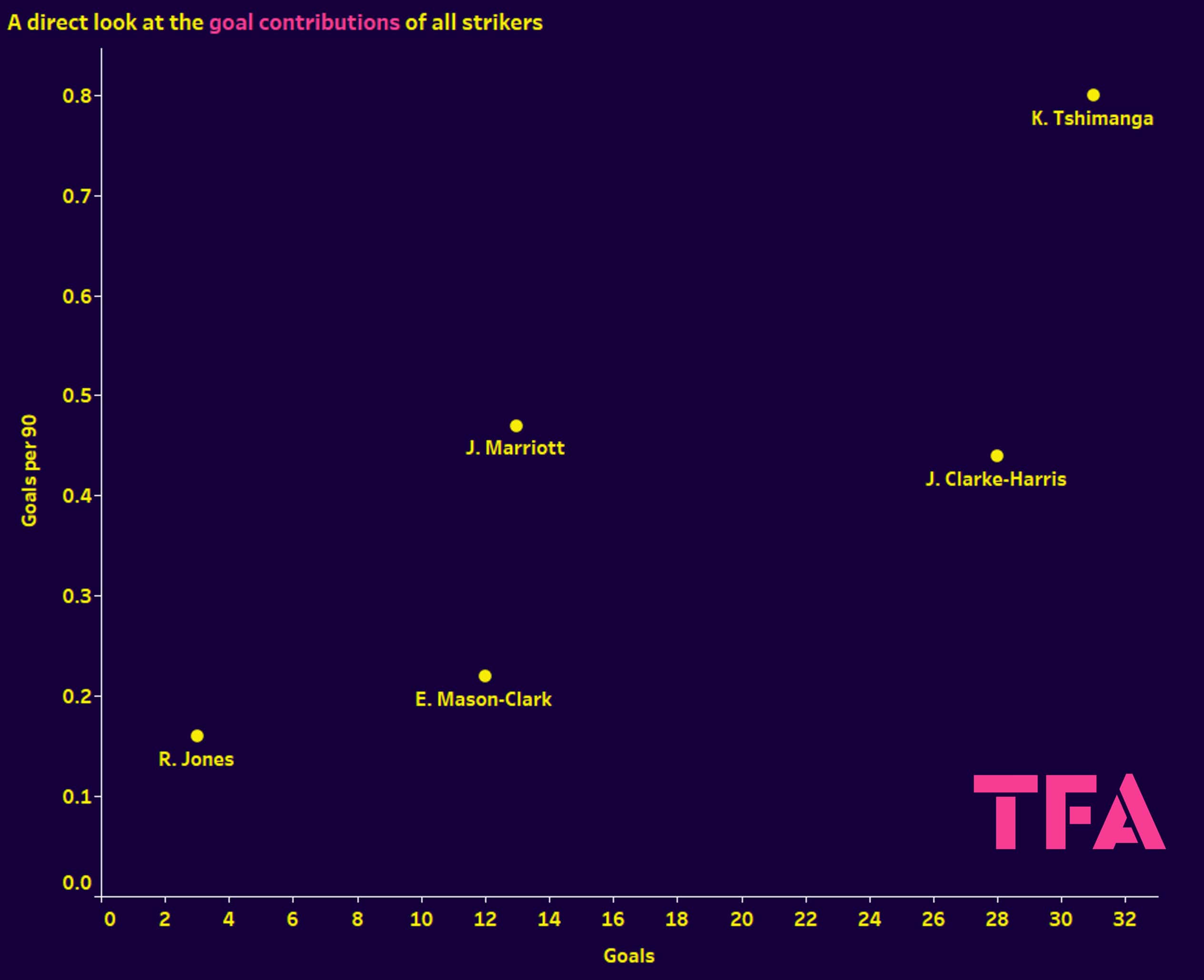
If you Peterborough fans weren’t that excited about your newest addition to the strike force before, you probably are now. Tshimanga leads the way in both goals scored and goals per 90, which indicates a healthy consistency when it comes to putting the ball in the back of the net. The now former Chesterfield forward has bagged 31 league goals since the start of 21/22, while Clark-Harris is just behind on 28 goals – an impressive feat considering his side were relegated last season.
Mason-Clark, a current England C international who can play on the wing as well as a centre forward, has lent his hand to the goalscoring, with the 23-year-old scoring 12 times, giving him an average of 0.22 goals per 90. It is possible that he is featured more prominently on the wing from now on as long as Clarke-Harris and Tshimanga are both fit and firing.
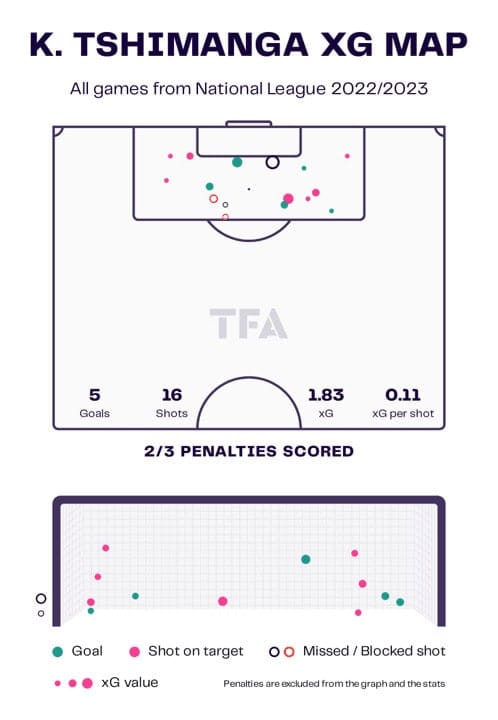
Let’s take a moment to dive into Tshimanga’s xG map from this season while at Chesterfield. Five non-penalty goals from 16 shots show a decent return, while only four of his efforts on goal have been either blocked or off target. He is most active inside the box; in fact, he hasn’t even registered a single strike on goal from outside of the area, which is also a reflection of Chesterfield’s tactics as well as his deadly nature inside the area.
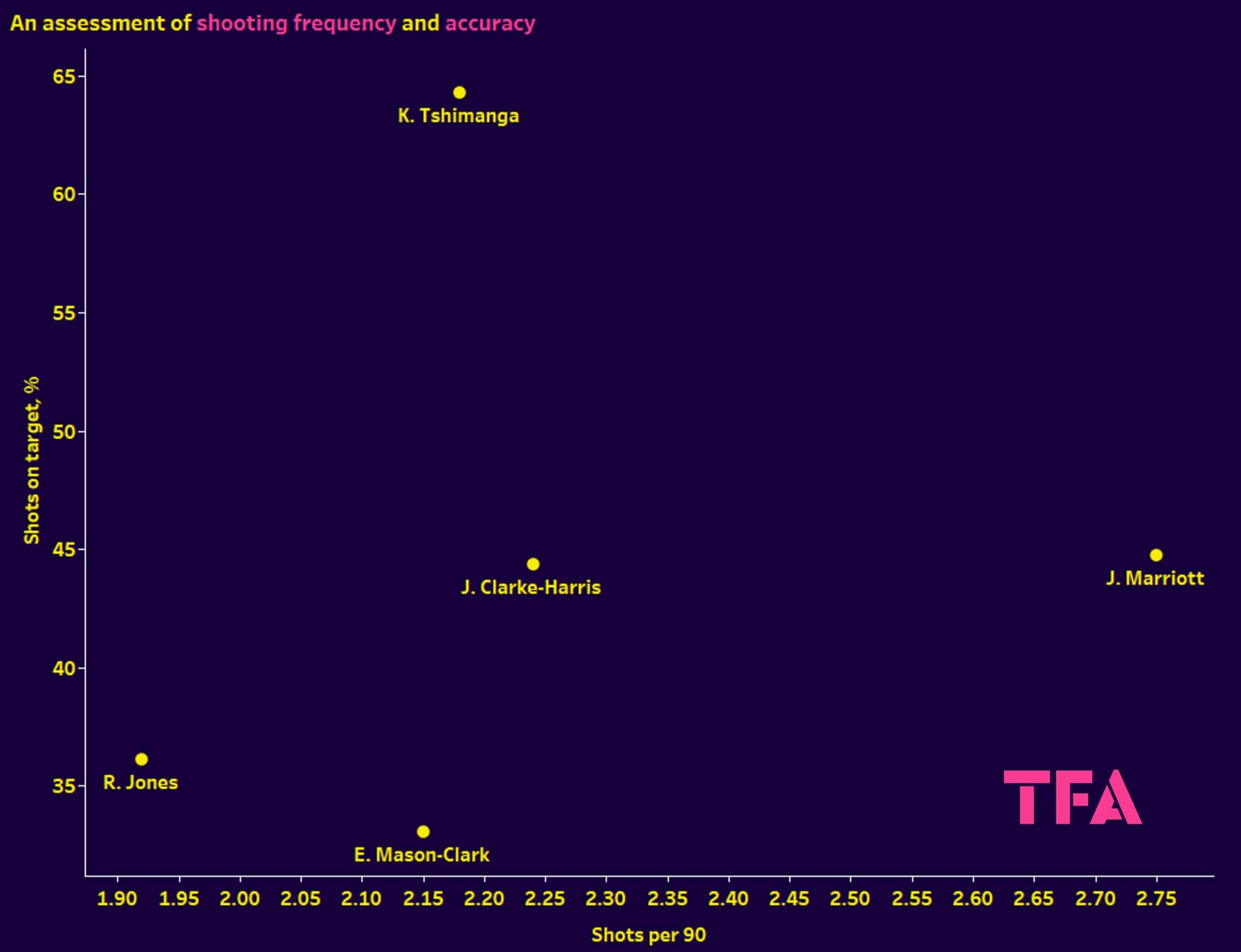
It is well known in the footballing world that strikers have to be somewhat selfish in their play when the time is right. Their primary job in the team is to get the goals, that is what they are paid to do, so, naturally, we see them taking more shots on goal than other players.
Jack Marriott is a great example of pulling the trigger at the slightest glance on goal, with the travelled EFL striker having scored plenty of big goals in his career. Marriott has averaged 2.75 shots per 90, with an accuracy rate of 44.74% – Tshimanga is excelling when it comes to accuracy (64.29%) but will be encouraged to unleash a shot more often than his current average of 2.18 shots per 90.

Diving even deeper into each player’s efficiency in front of goal allows us to learn more about their true striking ability, with the goal conversion metric being a very telling measurement. Again, Tshimanga leads the way with a conversion rate of 36.9% – Clarke-Harris comes closest to that with 19.7%, highlighting Tshimanga’s immense finishing quality. Jones (8.3%) and Mason-Clark (10.4%) will both want to improve their striking qualities even if they are deployed as wingers.
The modern striker: capable in other areas
We mentioned how strikers are judged on the number of goals they score, and that will never change. But the way the game has evolved over the last decade or two has given strikers more responsibility, getting involved in other areas that require ability other than scoring goals.

We begin by looking at the average number of successful attacking actions made by each player per 90 minutes. This metric involves all aspects of attack and essentially lets us see how effective they are on the whole without pinpointing any specific areas of strength or weakness.
This is where we start to see the strengths of those who play in wide areas as well, as they will be very efficient when it comes to things like dribbling and creating goal-scoring opportunities. Mason-Clark leads the way since the start of last season, averaging 5.8 successful attacking actions per 90, with Jones not far behind with 5.49. These two may not have the numbers when it comes to scoring goals, but if you watch Peterborough, you will quickly get a sense of how important they can be for their side. Jack Marriott leads the way out of the remaining forwards, averaging 2.93, with Tshimanga just behind on 2.8.
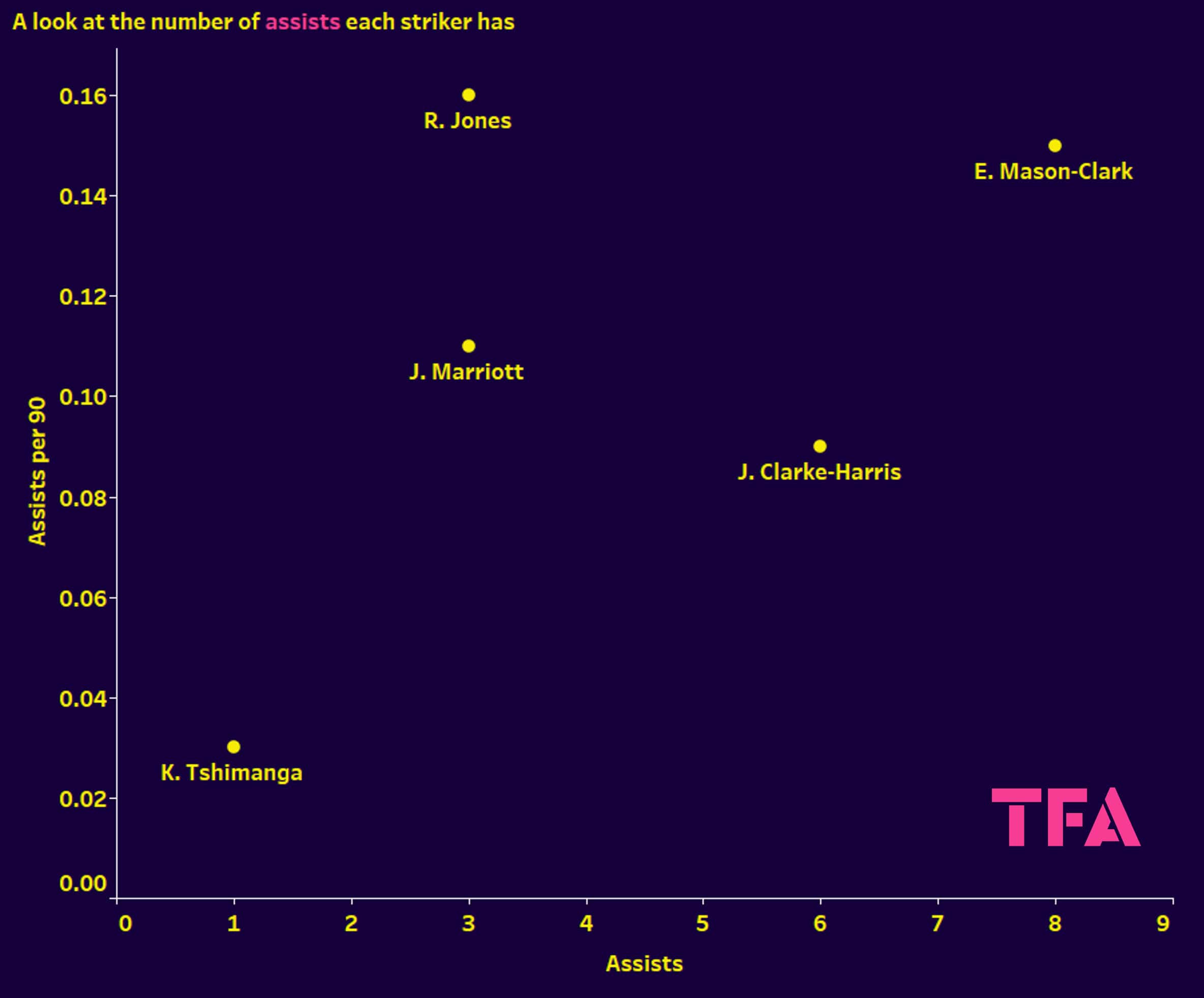
Setting up opportunities for teammates is also a very important element of a striker, and they have to possess the vision and technical ability to bring others into play when it isn’t possible to score themselves. While strikers aren’t necessarily judged on their assist record, this metric can tell you a lot about the striker’s style.
As you would expect, Jones and Mason-Clark lead the way – Jones may have three assists which is the same total as Marriott and three less than Clarke-Harris, but his assists per 90 rate is 0.16, far higher than both strikers in that area. Mason-Clark really is a name to remember when it comes to creativity: eight assists – 0.15 per 90. Tshimanga has just one assist since the start of last season, and this is where we see an area that needs to be improved at a higher level. If you have seen Tshimanga play, you’ll know that his off-the-ball movement and involvement are good, but a lot of his game is either assisting in build-up play in deeper areas, or he’s lurking in the box awaiting a delivery.
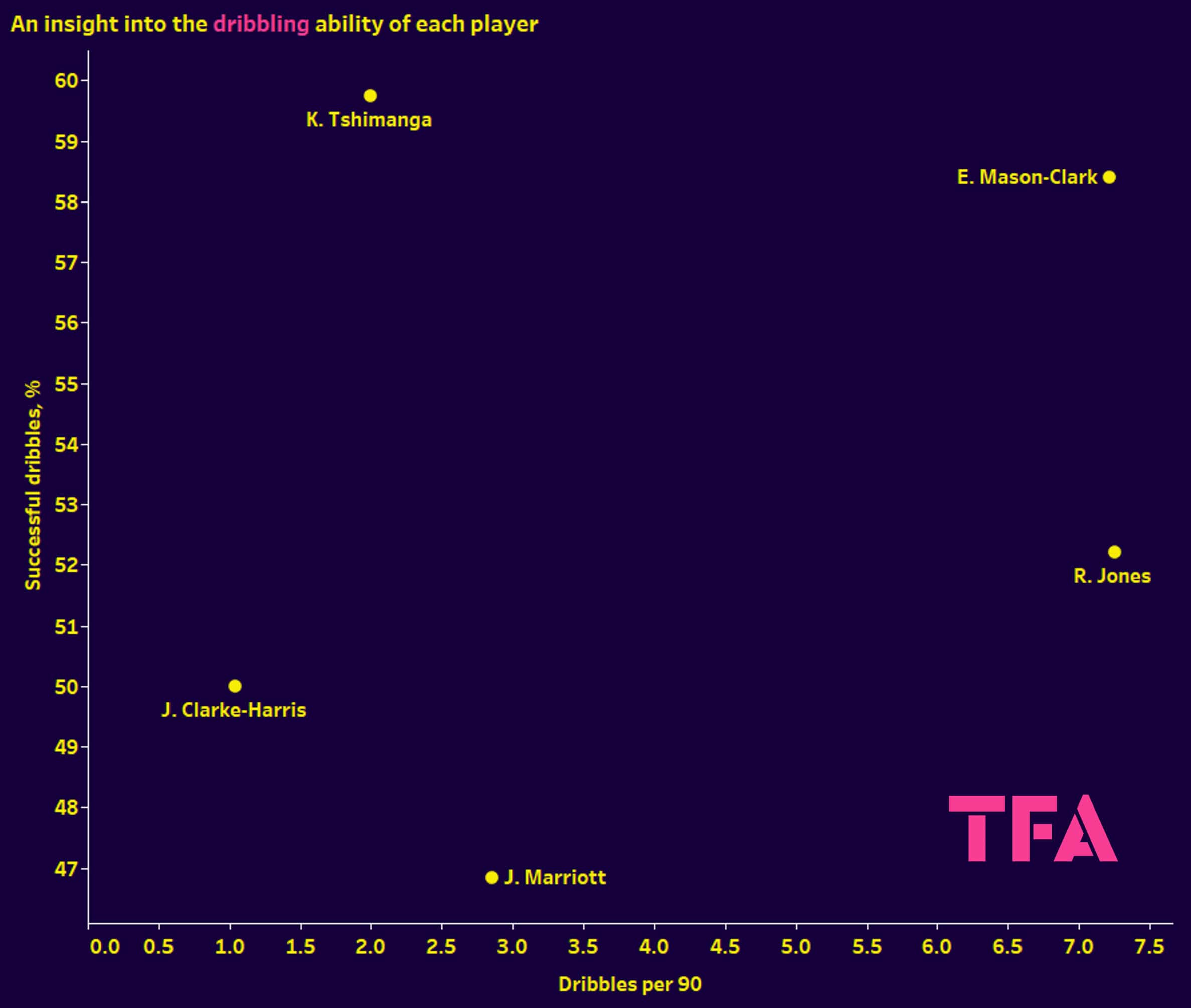
Being able to carry the ball is an important skill for a player of any position, but when a striker runs with the ball, he is usually the furthest man forward for his team, so it is usually in potentially dangerous areas, but also means that they dribble less than midfielders or wingers, for example. While Tshimanga, Marriott, and Clarke-Harris led the way in all things shooting and scoring, we are really seeing the value of Jones and Mason-Clark when it comes to more creative metrics. For the sake of analysing Tshimanga and discussing his potential impact on Posh’s squad, we will focus on the three central forwards for this one.
Interestingly, each player has a different story when it comes to dribbling. Clarke-Harris very rarely dribbles (1.04 per 90) and has a low success rate (50% – which would be a good number if his average number of attempts was higher). Marriott has a fairly high dribbling tendency for a striker (2.86 per 90) with a lower success rate, while Tshimanga attempts less than Marriott (two per 90) yet has a very impressive success rate of 59.74%, indicating another layer of talent to the former National League goal machine. He perhaps owes this to his physical strength, as he is difficult to knock off the ball and knows how to use his body in order to make it difficult for the opposition.
Conclusion
As we mentioned at the start, it is important to remember the circumstances surrounding the data and that Tshimanga was playing at a lower level etc. However, the numbers don’t lie. The National League may be a lower level than League One, but it is still incredibly physical and extremely difficult to be successful in, and Tshimanga found a way to look unstoppable in front of goal for the most part of the last season and a half.
He will hope to find more of last season’s form in a Peterborough shirt, and if the data tells us anything, it is that he is more than capable of doing so. He is clinical in front of goal, and while he may not be as involved when it comes to chance creation, he certainly has the talent to offer in a variety of areas. We may just see the 25-year-old flourish at a higher level, and who knows, he may even make it to the Premier League someday!

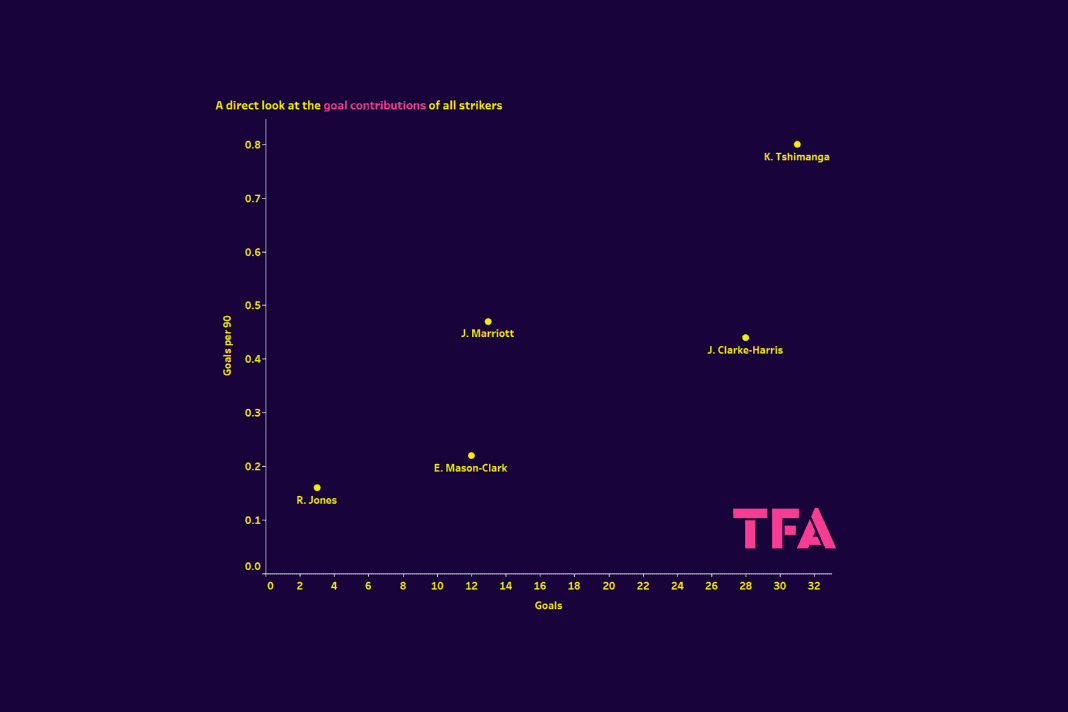




Comments